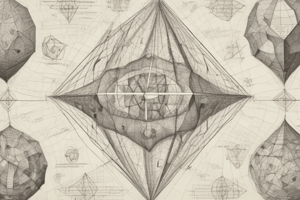Podcast
Questions and Answers
What is the definition of perimeter?
What is the definition of perimeter?
The total length of a shape's boundary.
Can you give an example of a postulate in geometry?
Can you give an example of a postulate in geometry?
Euclid's First Postulate: 'A straight line can be drawn from any point to any other point.'
How do engineers and architects use geometry in their work?
How do engineers and architects use geometry in their work?
To design buildings and infrastructure.
What is the Pythagorean Theorem and in what type of triangle does it apply?
What is the Pythagorean Theorem and in what type of triangle does it apply?
What is the relationship between area and perimeter?
What is the relationship between area and perimeter?
Flashcards are hidden until you start studying
Study Notes
Exploring Mathematics: The World of Geometry
Geometry is a branch of mathematics that deals with the properties and relationships of points, lines, angles, surfaces, and solids. It's a vital part of our daily lives, shaping the design of buildings, transportation systems, and even the technology we use. Let's delve into the fascinating world of geometry, exploring some of its fundamental concepts and real-world applications.
Points, Lines, and Planes
At the heart of geometry lies the concept of points. A point is a location in space with no size or dimension. A line is a collection of points that extend infinitely in both directions. Lines divide a plane into an infinite number of regions, often referred to as half-planes.
A plane is a two-dimensional surface that extends infinitely in all directions. Planes can intersect in lines and can be parallel or perpendicular to each other. Parallel lines never intersect, while perpendicular lines intersect at a right angle.
Angles and Measurement
Angles are formed where two lines intersect. They are measured in degrees, with a complete circle containing 360 degrees. Angles are classified into three types: acute, right, and obtuse. Acute angles are less than 90 degrees, right angles measure 90 degrees, and obtuse angles are greater than 90 degrees but less than 180 degrees.
Measuring angles is a fundamental skill in geometry. The most common instruments used for measuring angles are protractors and rulers. Protractors provide an accurate measurement of the angle's degree. Rulers are used to draw perpendicular and parallel lines, which aid in calculating angles.
Concepts of Area and Perimeter
Understanding the concept of area and perimeter is essential in geometry. The area of a shape is the amount of space it occupies, while the perimeter is the total length of its boundary. To calculate area, we use formulas, such as the area of a rectangle (length multiplied by width) and the area of a circle (π multiplied by the square of its radius).
Theorems and Postulates
Geometry is rich in theorems and postulates. A theorem is a statement that can be proven to be true using geometry principles and definitions. The Pythagorean Theorem, for example, states that in a right triangle, the square of the hypotenuse is equal to the sum of the squares of the other two sides.
Postulates, on the other hand, are statements that are considered to be true without proof. One of the most famous postulates in geometry is Euclid's First Postulate, which states that a straight line can be drawn from any point to any other point. Together, theorems and postulates form the foundation of geometry.
Geometry in Real Life
Geometry is not just about formulas and theorems; it's a powerful tool that can be used to solve real-world problems. Engineers and architects use geometry to design buildings and infrastructure. Geometric shapes are also used in various fields, such as art, fashion design, and graphic design, to create visually appealing and balanced compositions.
In conclusion, geometry is a fascinating and practical field that teaches us about the properties and relationships of shapes. Understanding geometry can help us solve complex real-world problems, appreciate the beauty of architecture and design, and improve our ability to reason and think logically. So, the next time you look at a building's design or a painting's composition, remember the rich history and practical applications of geometry that have shaped them.
Studying That Suits You
Use AI to generate personalized quizzes and flashcards to suit your learning preferences.




